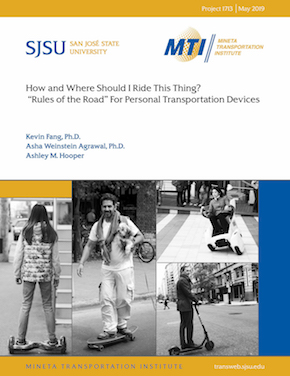- 408-924-7560
- mineta-institute@sjsu.edu
- Donate
How and Where Should I Ride This Thing? “Rules Of The Road” for Personal Transportation Devices
In recent years, “Personal Transportation Devices” (PTDs) have exploded onto streets and sidewalks. These small devices transport individual persons at slow speeds and are either human-powered or motorized. Examples include electric (kick) scooters, skateboards, e-skateboards, roller blades, and Segways. One key to successfully integrating PTDs into community streets will be the implementation of consistent and suitable regulations over user behavior: “rules of the road” for PTD riders. To help local officials identify appropriate rules for rider behavior, this report documents and analyzes existing PTD regulations across 176 jurisdictions and then presents recommendations for a set of state-level “rules of the road” designed to balance safety and freedom of movement for all road users, including PTD riders.
To identify the current state of PTD rules of the road, we documented and analyzed the existing regulations at three levels of government: all 50 states and 5 U.S. territories, 101 cities, and 20 college campuses. This review found that PTD users operate in a murky regulatory environment, with rules often poorly defined, contradictory, or altogether absent.
Results of this analysis, a literature review, and interviews with 21 stakeholders, were used to craft a model state-level regulatory code that aims to introduce consistent and well-grounded regulation of PTDs. The general philosophy underpinning the model legislation is that PTD rules should protect public safety, permit PTD use as a convenient travel option, be easy to understand and remember, allow for new devices without new regulations, and be based on facts about PTD use and users. Working from these principles, core recommended elements of the recommended PTD regulations are as follows: states should set comprehensive regulations for PTD riders (with local gov-ernments given flexibility to limit certain uses when necessitated by local conditions); PTDs should be regulated as a class, not device-by-device; and PTD users should be permitted to ride on both streets and sidewalks, subject to rules that protect safety and free movement for all travelers.
KEVIN FANG, PhD
Dr. Fang is Assistant Professor of Geography, Environment, and Planning at Sonoma State University. His research centers on the characteristics of sustainable alternative modes of transportation and their users. His work includes recent publications on skateboard travel—an early foray into the emerging “micromobility” trend. He also works in the areas of transportation impact analysis in environmental review. He holds a BA from the University of California, Berkeley in Integrative Biology; a Masters of City and Regional Planning and an MS in Engineering (Specialization in Transportation Planning) from the California Polytechnic State University; and a PhD from the University of California, Davis in Transportation, Technology, and Policy.
ASHA WEINSTEIN AGRAWAL, PhD
Dr. Agrawal is the Director of the MTI National Transportation Finance Center and also Professor of Urban and Regional Planning at San José State University. Her research and teaching interests in transportation policy and planning include bicycle and pedestrian planning, travel survey methods, and transportation finance policy. She also works in the area of transportation history. She has a BA from Harvard University in Folklore and Mythology; an MSc from the London School of Economics and Political Science in Urban and Regional Planning; and a PhD from the University of California, Berkeley, in City and Regional Planning.
ASHLEY M. HOOPER
Ms. Hooper is a doctoral candidate in Urban and Environmental Planning and Policy at the University of California, Irvine, within the Department of Urban Planning and Public Policy. Her research interests relate broadly to issues of sustainability and resilience within urban socio-ecological systems. Her dissertation examines how “resilience” is conceptualized by key actors within food systems and addressed through local food policies. She also draws from critical eco-feminist theory to examine the role of gender in building environmental and social capacity. Her teaching interests include qualitative research methods, urban planning and public policy, environmental policy, and environmental justice. She holds a BS in Psychology and a Masters of Water Resources (Specialization in Policy and Management) from the University of New Mexico.
-
Contact Us
San José State University One Washington Square, San Jose, CA 95192 Phone: 408-924-7560 Email: mineta-institute@sjsu.edu






